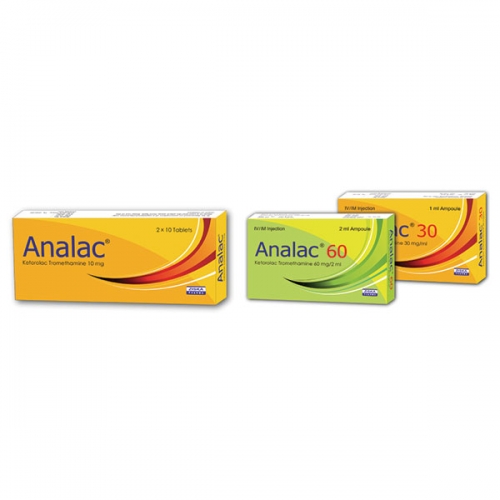ঔষধের বিস্তারিত বা বিকল্প ঔষধ জানতে ঔষধের নাম দিয়ে সার্চ দিন। যেমন- Napa বা Alatrol বা Amodis
Analac 10mg
TabletKetorolac Tromethamine
Ziska Pharmaceuticals Limited
Other Strength:
Alternative:
- Xidolac Meltab 10mg
- WINOP 10mg
- Torax 10mg
- Zeropain 10mg
- Toramax 10mg
- Minolac 10mg
- Ketofast 10mg
- Doltro 10mg
- Xiroket 10mg
- Tolec 10mg
- Toro 10mg
- Ketoroz 10mg
- Ketobe 10mg
- Lacor 10mg
- Rolac 10mg
- Rolac MDT 10mg

Analac
Presentation
Analac 10 Tablet: Each tablet contains Ketorolac tromethamine USP 10 mg.
Analac 30 Injection: Each 1 ml ampoule contains Ketorolac tromethamine USP 30 mg.
Analac 60 Injection:Each 2 ml ampoule contains Ketorolac tromethamine USP 60 mg.
Description
Ketorolac tromethamine is a non-steroidal anti-inflammatory drug (NSAID) that exhibits analgesic, anti-inflammatory, anti-pyretic activity. Ketorolac tromethamine inhibits synthesis of prostaglandins and may be considered a peripherally acting analgesic. The biological activity of ketorolac tromethamine is associated with the S-form. Ketorolac tromethamine possesses no sedative or anxiolytic properties. Ketorolac tromethamine 30 mg intramuscularly appears to be similar in efficacy to morphine 10 mg and superior to pethidine 100 mg. It has no opioid activity and thus does not present a problem of addiction.
Indications
Analac is indicated for the short term management of moderate to severe acute post-operative pain,dental pain, orthopaedic pain, renal colic, nephrolithiasis, cancer pain, musculo-skeletal pain
Dosage & Administration
Injection: Single-dose treatment: Adult (Under 65 years of age): Single daily dose of 60 mg in IM route or 30 mg in IV route. Elderly (65 years of age and older): Single daily dose of 30 mg in IM route or 15 mg in IV route. Multiple-dose treatment: Adult (Under 65 years of age): 30 mg IV/IM every 6 hours up to a maximum daily dose of 90 mg. Elderly (65 years of age and older): 30 mg IV/IM every 6 hours up to a maximum daily dose of 60 mg. Oral: Adult (Under 65 years of age): The usual oral dose is 10 mg every 4 to 6 hours, as required. Doses exceeding 40 mg per day is not recommended. Elderly (65 years of age and older): The usual oral dose is 10 mg every 6 to 8 hours.Daily doses of 30 mg to 40 mg per day should not be exceeded. The use of Ketorolac Tablets is recommended for the shortest possible time. Conversion from IV/IM to Oral Therapy: Adult patientsless than 65 years of age who received 60 mg IM single dose or 30 mg IV single dose or 30 mg multiple dose: 20 mg (2 tablets) as a first oral dose, followed by 10 mg (1 tablet) every 4-6 hours,not to exceed 40 mg in 24 hours of Ketorolac oral. Patient greater than or equal to 65 years of age,renal impaired or less than 50 kg of body weight who received 30 mg IM single dose or 15 mg IV single dose or 15 mg Multiple dose: 10 mg (1 tablet) as a first oral dose, followed by 10 mg (1 tablet) every 4-6 hours, not to exceed 40 mg in 24 hours of Ketorolac oral. For patient being converted from IV/IM Ketorolac to oral Ketorolac, the total combined daily dose should not exceed 90 mg (60 mg for the elderly, mild renal-impaired patients and patients weighing less than 50 kg) and the oral component should not exceed 40 mg (30 mg to 40 mg for the elderly) on the day change of formulation is made. Patient should be converted to oral treatment as soon as possible.
Precautions
Precaution should be taken in elderly, allergic disorder, renal, cardiac & hepatic impairment, porphyria, patient with low body weight (<50 kg)
Contraindications
Known hypersensitivity to the drug, asthma, syndrome of rhinitis and nasal polyposis, active peptic ulceration or gastrointestinal bleeding, pre-renal conditions including renal artery stenosis, hypovolemia or dehydration, disorders of coagulation or platelet function, cirrhosis of liver or ascites,suspected or confirmed cerebrovascular bleeding, concomitant use with NSAIDs.
Use in Pregnancy & Lactation
The safety of ketorolac in human pregnancy has not been established. It is therefore contraindicated during pregnancy, labor or delivery. As ketorolac has been detected in human milk at low levels, it is also contraindicated in mothers who are breast-feeding.
Commercial Packaging
10 Tablet: Each carton contains 2x10's tablets in blister strip.
Analac 30 Injection: Each carton contains 1 ampoule in blister pack and a 3 ml sterile disposable syringe.
Analac 60 Injection:Each carton contains 1 ampoule in blister pack and a 3 ml sterile disposable syringe.
Adverse Reactions
Adverse effects: Gastrointestinal tract: Abdominal discomfort, diarrhoea, dyspepsia, gastrointestinal pain, nausea, peptic ulcer, perforation, vomiting. Central nervous/musculoskeletal systems: Somnolence, dizziness, drowsiness, dry mouth, excessive thirst, headache, insomnia, myalgia, nervousness, paresthesia, stimulation, sweating, tinnitus, vertigo. Urinary tract and kidneys: Impairment of renal function has been documented with long-term use. Respiratory system: Asthma,dyspnoea.
Drug Interaction
Methotrexate, diuretics, ACE inhibitors, warfarin, lithium, aminoglycosides, antiepileptic drugs, psychoactive drugs and other NSAIDs.
Overdose
In controlled overdosage, daily doses of 360 mg of ketorolac injection given for 5 days (four times the highest recommended dose), caused abdominal pain and peptic ulcers which healed after discontinuation of dosing. Metabolic acidosis has been reported following intentional overdosage. Single overdoses of ketorolac have been variously associated with abdominal pain, nausea, vomiting, hyperventilation, peptic ulcers and/or erosive gastritis and renal dysfunction which have resolved after discontinuation of dosing. Dialysis does not significantly clear ketorolac from the blood stream
Storage
Store in a cool & dry place, protected from light.
এই পাতাটি ১৯৪ বার দেখা হয়েছে
রাজডক কী?
ফ্রী সদস্য হোন Click Here
ডাক্তার হিসাবে যোগদান করতে Click Here
নার্স / টেকনোলজিস্ট হিসাবে যোগদান করতে Click Here
ফ্রী সদস্য হোন Click Here
ডাক্তার হিসাবে যোগদান করতে Click Here
নার্স / টেকনোলজিস্ট হিসাবে যোগদান করতে Click Here

